“Reaping the Rewards” shows you the finished product from a crowdfunding campaign. Today’s topic is Go Nuts for Donuts, one of my family’s favorites. Go Nuts for Donuts was funded on Kickstarter in September 2016 by Daily Magic Games; it was subsequently picked up by Gamewright, which produced it and delivered it to backers in July 2017 (but more on that later). This review is adapted from my original Kickstarter Tabletop Alert.
Yay, somebody brought donuts! Quick—grab your favorites before they’re gone, but watch out: all those hands mean that some donuts are gonna get squashed. It’s time to Go Nuts for Donuts!
Go Nuts for Donuts at a Glance
Go Nuts for Donuts! is a quick-playing game about grabbing tasty treats by Zach Eagle for 2 to 6 players, ages 8 and up, and takes about 20 minutes to play. The retail price is $14.99, and it’s hitting store shelves and Amazon today. It’s a family-friendly game that involves choosing donuts simultaneously, and has delightfully cute artwork.
Go Nuts for Donuts is GeekDad Approved!

Go Nuts for Donuts Components
- 70 Donut cards
- 42 Selection cards (Numbers 1–7, 6 copies of each)
- 7 Donut Row tokens
- 25 Bonus Donut cards (Kickstarter only)
The donut artwork by Claire Donaldson is really adorable—they all have cute little faces on them. There have been some changes between the illustrations seen in the prototypes and the Kickstarter campaign and the finished product—after Gamewright acquired the game, they wanted to make some of their own design choices, which upset some Kickstarter backers. For instance, the donut names are now in a simpler sans serif font rather than the fancier italics of the prototype; there’s also a lot less pink overall. The donuts themselves are mostly unchanged, but are now on round white plates instead of square purple plates (with that little bit of wax paper). I do have a slight preference for the prototype version, but I don’t feel too strongly about it—and for anyone who just comes across the game in the store and doesn’t have the prototype to compare it to, I think they’ll be pleased with the look.
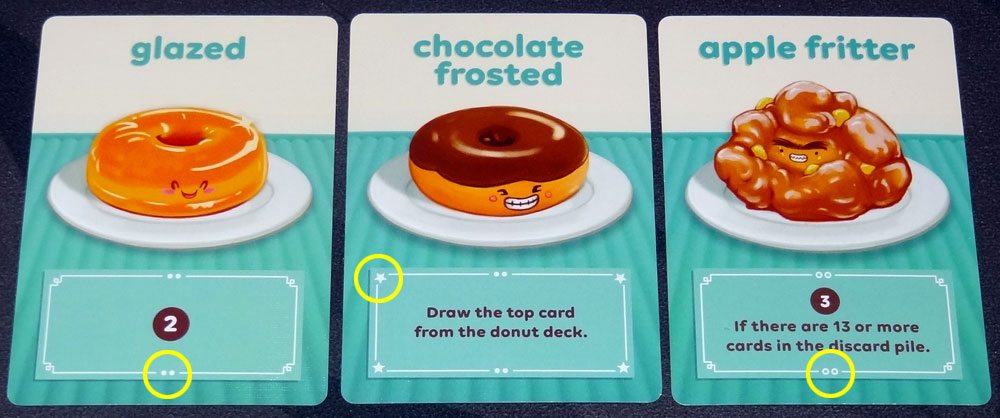
Each card has a name, illustration, and then a section that tells how many points the donuts is worth or if it has some special action. This is my only real (though minor) complaint about the design on the cards: the symbols used are very tiny. At the top and bottom of each “frame” there are some dots, indicating the player count at which you would include the donuts. So you always use the 2-dot cards, but then add in the 3-dot cards for three players, and so on. For Kickstarter backers, there are bonus donuts (added during the Kickstarter campaign as stretch goals)—these are marked with outline dots rather than solid dots, also very tiny. Finally, some donuts have special actions that take place as soon as you get the donut, and they’re marked with tiny stars in the corners of the frames. All of these symbols are very small and I’m not sure why they couldn’t have been a little more visible.
That said, the reason it is only a minor complaint for me is that the symbols aren’t absolutely necessary. The player count is also distinguished by the table color, so you could sort out the cards that way rather than referring to the dots. Action cards have action text on them, so it’s pretty obvious—but then the stars could have been omitted altogether. And once you’ve shuffled in the bonus donuts, you’ll probably just want to keep playing with them anyway, so maybe you don’t need to separate them out anyway.

There are 10 bonus card types that were added to the game thanks to stretch goals for Kickstarter backers, even including some non-donuts (like cupcakes and bacon). These are also sorted by player count, and add some more variety to the mix. The one odd thing is that I didn’t see anywhere in the rulebook or the “Bonus Donut Guide” sheet about how you use them—do you remove a donut type and substitute one of these in? Or do you just shuffle them in? If you buy this game in the store, you’ll get the base game with 70 donut cards, and the bonus cards may be sold separately later on as an expansion or as promotional items.

The selection cards are half-sized cards, and each player will get a set of the numbers, which are made to look like various types of donuts. The donut row tokens are cardboard tokens with matching numerals on them. I’m really glad these are included, because they weren’t in the prototype, and it makes it a lot easier to ensure that you’re actually picking the right card for the donut you want.
How to Play Go Nuts for Donuts
A copy of the rulebook (including print-and-play cards) is available, but note that this is from the Kickstarter campaign and some of the donut types and their effects have been swapped around in the final version.
How to Win
The goal is to score the most points by the end of the game by collecting donuts.

Setup
To set up, shuffle all of the donut cards for the appropriate player count. Give each player a set of selection cards—you’ll only need numbers up to the player count plus 1, so for a four player game each player would get 1 through 5 and the rest go back in the box. Set out the corresponding donut row tokens in the center of the table. Place that many donut cards face-up in a row in the center of the table.
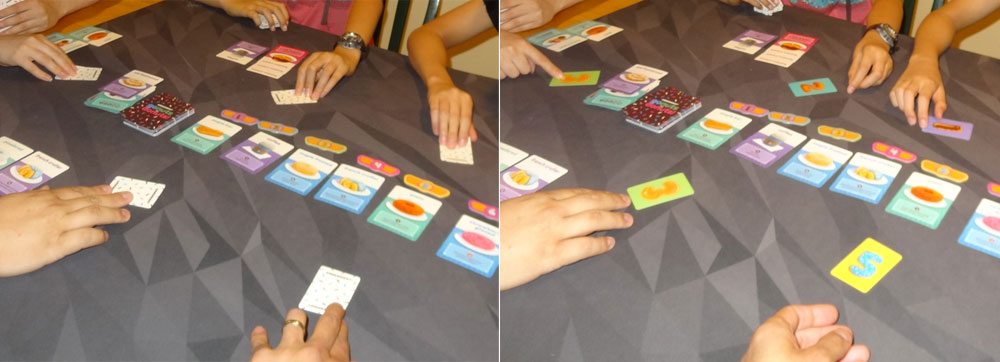
Pick Your Donuts!
Each player chooses a selection card secretly to indicate which donut they want. All selection cards are revealed simultaneously, and then resolved in ascending order. If only one player chose a particular donut, the player takes that donut and, if applicable, immediately uses the donut’s action. (Note: the donut actions are only resolved when you take a donut from the center row, not if a donut action causes you to get a donut from the discard pile, the deck, or another player.)
If more than one player selects the same donut, the donut gets squashed and put in the discard pile. (For instance, in the photo above, two players picked #3, so donut #3 will get discarded.) After all selections have been resolved, refill the row and all players take back their selection cards and choose again.
The game ends when there aren’t enough donut cards to refill the center row.

Scoring
Players add up the points on all of their donuts, and the highest score wins.
There are many types of donuts with different scoring mechanics. The simplest ones just have a single point value on them—you get it, you get that many points. Some, like those pictured above, score based on how many you have.

Not all donuts are good for you, though. There are a few types that will cost you points if you get stuck with them by the end of the game, but they tend to have fairly powerful actions. The trick is to get rid of them before final scoring. The day-old donuts, for instance, are a whopping -7 points, but you can take any 3 cards from the discard pile—that could be enough to offset the loss.

There are a few types of donuts that score based on the rest of your collection: you may need to hit a certain target number of donut types, or have the fewest cards.

Many of the cards with special actions are not worth points themselves—they just help you get more cards, or maybe get rid of cards. There’s always a chance with these, of course, because you might end up getting a bad donut from that draw. Donuts that you get from the deck, discard pile, or other players do not trigger their special actions.
The Verdict
Go Nuts for Donuts! is a quick, easy-to-learn game, and it’s been a crowd-pleaser. Almost everyone I’ve introduced it to has enjoyed it, and my kids absolutely love it. I liked it so much that even after I reviewed the Kickstarter, I kept the prototype around so that we could keep playing it while waiting for the finished version. On my recent trip to visit family, I finally bequeathed the prototype to my nieces and nephew, knowing that the finished copy would be arriving soon. The cousins got a lot of play out of it during the trip!
Gamewright and Daily Magic Games
As I mentioned at the top, Go Nuts for Donuts was originally to be published by Daily Magic Games, which has also published the Valeria line of games as well as several others. They’re up here in the Pacific Northwest, so I see them at many of the local gaming conventions and have gotten to know them, and I’ve really enjoyed a lot of the games that they’ve published.
Gamewright is a well-known publisher of family-friendly games, and when parents ask for recommendations for games for younger kids, Gamewright is one of my go-to suggestions. Many of their games are affordable, accessible for kids, but also fun for adults. So when I heard that Go Nuts for Donuts had been signed to Gamewright, I thought it was a really great fit. Plus, because Gamewright is a larger publisher, it means that even more people will get to see Go Nuts for Donuts, since Gamewright games are sold not only in tabletop game stores, but also bookstores like Barnes & Nobles, and retailers like Target. I’m glad to see that both Go Nuts for Donuts and Daily Magic Games will get even more exposure through this agreement.

Gameplay
The basic gameplay is really intuitive: you’re all reaching for donuts simultaneously, and if you grab the same donut, nobody gets it. The mix of donut points and actions is what makes it really interesting, of course. That part reminds me a little of Sushi Go!, both because of the cute illustrations and because there are different scoring rules for each donut. Knowing when to use a negative-point donut is important, because you want to make sure you don’t just lose points for no good reason.
Theme
Thematically, it can be a little odd. Why are the plain donuts more points if you get the most of them? Why does the eclair let you take the top card of the discard pile? For most of them, there’s no real explanation (unlike Sushi Go!, which tries to give at least a little bit of a story behind each card’s function). Still, that doesn’t really seem to bother most players in the least—you just figure out which donuts you want and grab them. Who doesn’t like donuts?
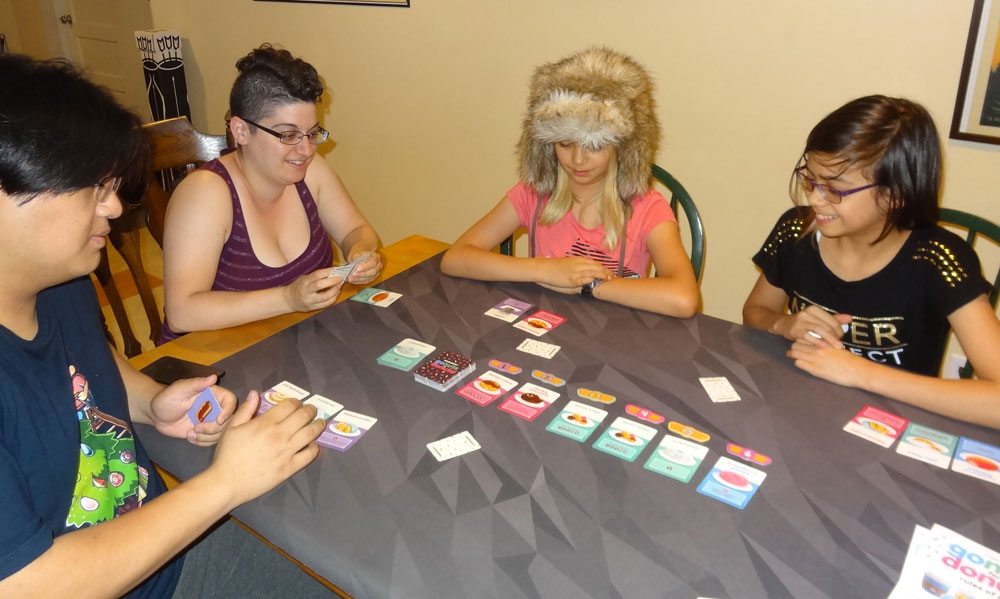
Strategy
Although it’s a simultaneous selection instead of drafting, a lot of the strategy can be similar—you try to figure out what your opponents want, and then sometimes you have to decide between picking the donut you really want, or taking the donut somebody else wants (even if it ends up smushed and discarded). I’ve played some games where a couple players clashed repeatedly, going after the same donuts round after round. If you have donuts that score points for having fewer cards or types of donuts, then you can afford not to take as many cards total.
Summary
All in all, Go Nuts for Donuts! is a real treat—it’s a great way to kick off a game night, and chances are you’ll play a couple times in a row, because once everyone is familiar with the types of donut cards in the deck, they’ll want another shot at sweet, sweet victory. The artwork is delicious, the gameplay is a snap to teach, and the chance to smash somebody else’s donut is just icing on the cake–or, I guess, maple glaze on the donut. One caveat: after playing this, everyone’s going to be hungry for donuts, so it might be best to have a box of real donuts ready, too.
Order a copy of Go Nuts for Donuts from Amazon, directly from Gamewright, or look for it at any store that sells games!
Click here for a full index of our tabletop game reviews.
Disclosure: I received a finished copy of the game for review purposes.
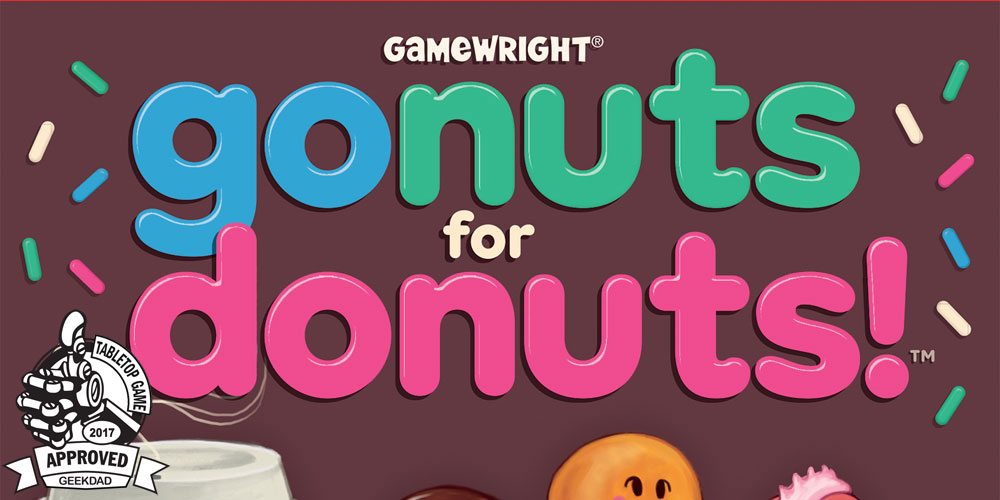

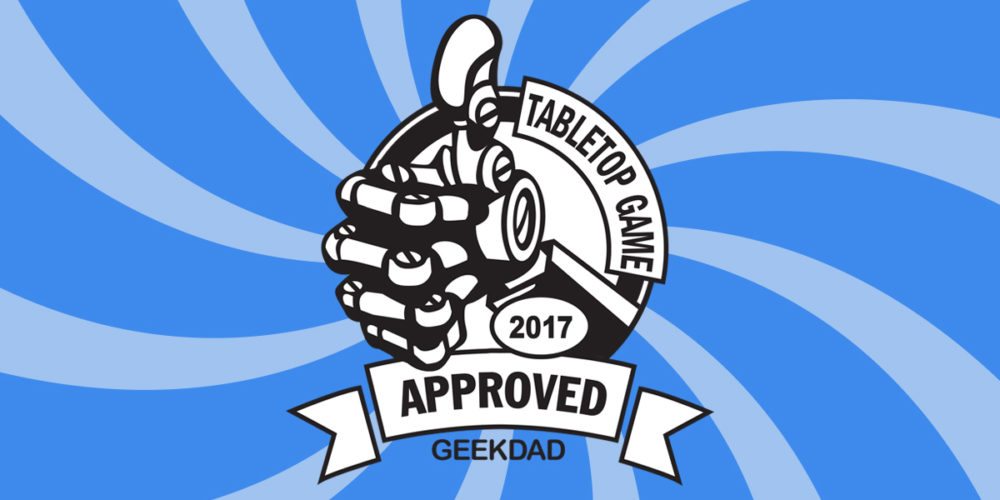




Hi! I really want to buy this game. Is there any way to buy the game with those bonus cards?
Hi! At this time I don’t think you can get the game with the bonus cards—the retail edition does not include them, and Gamewright doesn’t have them sale separately yet. I’ve been told that they may sell them later on as an expansion. The base game is still excellent, though, and can be found in game stores, Target, online, and other places!